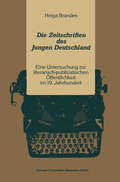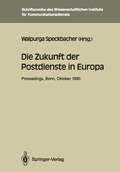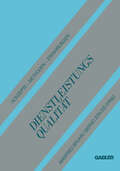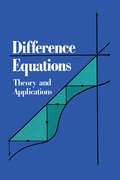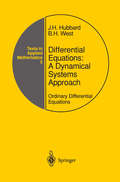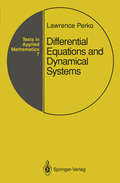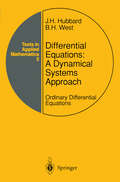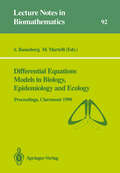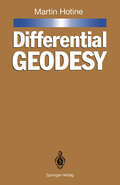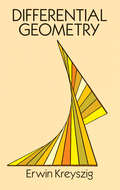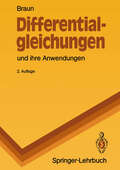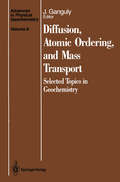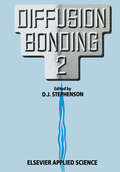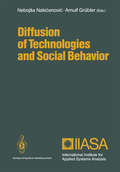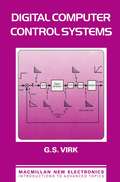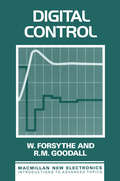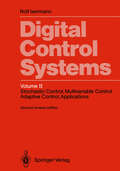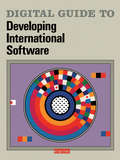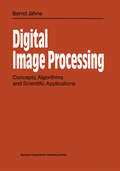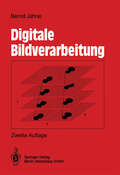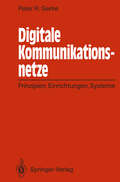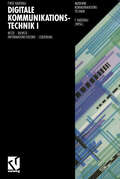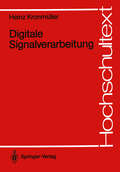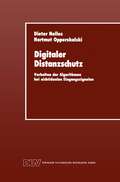- Table View
- List View
Die Zeitschriften des Jungen Deutschland: Eine Untersuchung zur literarisch-publizitischen Öffentlichkeit im 19. Jahrhundert (Kulturwissenschaftliche Studien zur Deutschen Literatur)
by Helga BrandesDie Zukunft der Postdienste in Europa: Proceedings der internationalen Konferenz „Die Zukunft der Postdienste in Europa“ Bonn, 25.–26.10.1990 (Schriftenreihe des Wissenschaftlichen Instituts für Kommunikationsdienste #11)
by Walpurga SpeckbacherDifference Equations, Second Edition
by Ronald E. MickensIn recent years, the study of difference equations has acquired a new significance, due in large part to their use in the formulation and analysis of discrete-time systems, the numerical integration of differential equations by finite-difference schemes, and the study of deterministic chaos. The second edition of Difference Equations: Theory and Applications provides a thorough listing of all major theorems along with proofs. The text treats the case of first-order difference equations in detail, using both analytical and geometrical methods. Both ordinary and partial difference equations are considered, along with a variety of special nonlinear forms for which exact solutions can be determined. Numerous worked examples and problems allow readers to fully understand the material in the text. They also give possible generalization of the theorems and application models.The text's expanded coverage of application helps readers appreciate the benefits of using difference equations in the modeling and analysis of "realistic" problems from a broad range of fields. The second edition presents, analyzes, and discusses a large number of applications from the mathematical, biological, physical, and social sciences. Discussions on perturbation methods and difference equation models of differential equation models of differential equations represent contributions by the author to the research literature. Reference to original literature show how the elementary models of the book can be extended to more realistic situations.Difference Equations, Second Edition gives readers a background in discrete mathematics that many workers in science-oriented industries need as part of their general scientific knowledge. With its minimal mathematical background requirements of general algebra and calculus, this unique volume will be used extensively by students and professional in science and technology, in areas such as applied mathematics, control theory, population science, economics, and electronic circuits, especially discrete signal processing.
Difference Equations, Second Edition
by Ronald E. MickensIn recent years, the study of difference equations has acquired a new significance, due in large part to their use in the formulation and analysis of discrete-time systems, the numerical integration of differential equations by finite-difference schemes, and the study of deterministic chaos. The second edition of Difference Equations: Theory and Applications provides a thorough listing of all major theorems along with proofs. The text treats the case of first-order difference equations in detail, using both analytical and geometrical methods. Both ordinary and partial difference equations are considered, along with a variety of special nonlinear forms for which exact solutions can be determined. Numerous worked examples and problems allow readers to fully understand the material in the text. They also give possible generalization of the theorems and application models.The text's expanded coverage of application helps readers appreciate the benefits of using difference equations in the modeling and analysis of "realistic" problems from a broad range of fields. The second edition presents, analyzes, and discusses a large number of applications from the mathematical, biological, physical, and social sciences. Discussions on perturbation methods and difference equation models of differential equation models of differential equations represent contributions by the author to the research literature. Reference to original literature show how the elementary models of the book can be extended to more realistic situations.Difference Equations, Second Edition gives readers a background in discrete mathematics that many workers in science-oriented industries need as part of their general scientific knowledge. With its minimal mathematical background requirements of general algebra and calculus, this unique volume will be used extensively by students and professional in science and technology, in areas such as applied mathematics, control theory, population science, economics, and electronic circuits, especially discrete signal processing.
Differential Equations: Ordinary Differential Equations (Texts in Applied Mathematics #5)
by John H. Hubbard Beverly H. WestThis corrected third printing retains the authors'main emphasis on ordinary differential equations. It is most appropriate for upper level undergraduate and graduate students in the fields of mathematics, engineering, and applied mathematics, as well as the life sciences, physics and economics. The authors have taken the view that a differential equations theory defines functions; the object of the theory is to understand the behaviour of these functions. The tools the authors use include qualitative and numerical methods besides the traditional analytic methods, and the companion software, MacMath, is designed to bring these notions to life.
Differential Equations and Dynamical Systems (Texts in Applied Mathematics #7)
by Lawrence PerkoAlthough this systematic study of autonomous systems begins with a thorough treatment of linear systems, the main emphasis is on local and global behavior of nonlinear systems. The main purpose of this revised edition is to introduce students to the qualitative and geometric theory of ordinary differential equations as well as serving as a reference book for mathematicians researching dynamical systems. Readers will find that, except for certain topics of current mathematical research, such as the number of limit cycles and the nature of attracting sets of dynamical systems, the global qualitative theory of a nonlinear dynamical system leads to an understanding of the solution set of the nonlinear system to rival that which we have of linear flows.
Differential Equations: Ordinary Differential Equations (Texts in Applied Mathematics #5 )
by John H. Hubbard Beverly Henderson WestDifferential Equations Models in Biology, Epidemiology and Ecology: Proceedings of a Conference held in Claremont California, January 13–16, 1990 (Lecture Notes in Biomathematics #92)
by Stavros Busenberg Mario MartelliThe past forty years have been the stage for the maturation of mathematical biolo~ as a scientific field. The foundations laid by the pioneers of the field during the first half of this century have been combined with advances in ap plied mathematics and the computational sciences to create a vibrant area of scientific research with established research journals, professional societies, deep subspecialty areas, and graduate education programs. Mathematical biology is by its very nature cross-disciplinary, and research papers appear in mathemat ics, biology and other scientific journals, as well as in the specialty journals devoted to mathematical and theoretical biology. Multiple author papers are common, and so are collaborations between individuals who have academic bases in different traditional departments. Those who seek to keep abreast of current trends and problems need to interact with research workers from a much broader spectrum of fields than is common in the traditional mono-culture disciplines. Consequently, it is beneficial to have occasions which bring together significant numbers of workers in this field in a forum that encourages the exchange of ideas and which leads to a timely publication of the work that is presented. Such an occasion occurred during January 13 to 16, 1990 when almost two hun dred research workers participated in an international conference on Differential Equations and Applications to Biology and Population Dynamics which was held in Claremont.
Differential Geodesy
by J. Zund J. Nolten B. H. Chovitz C. A. WhittenApart from Hotine's work on Mathematical Geodesy, several previously unpublished reports are collected in this monograph, complemented by extensive comments on these contributions and a complete bibliography of Hotine by the editor.
Differential Geometry (Dover Books on Mathematics)
by Erwin KreyszigThis outstanding textbook by a distinguished mathematical scholar introduces the differential geometry of curves and surfaces in three-dimensional Euclidean space. The subject is presented in its simplest, most essential form, but with many explanatory details, figures and examples, and in a manner that conveys the geometric significance and theoretical and practical importance of the different concepts, methods and results involved.The first chapters of the book focus on the basic concepts and facts of analytic geometry, the theory of space curves, and the foundations of the theory of surfaces, including problems closely related to the first and second fundamental forms. The treatment of the theory of surfaces makes full use of the tensor calculus.The later chapters address geodesics, mappings of surfaces, special surfaces, and the absolute differential calculus and the displacement of Levi-Cività. Problems at the end of each section (with solutions at the end of the book) will help students meaningfully review the material presented, and familiarize themselves with the manner of reasoning in differential geometry.
Differentialgleichungen und ihre Anwendungen (Springer-Lehrbuch)
by Martin BraunDieses richtungsweisende Lehrbuch für die Anwendung der Mathematik in anderen Wissenschaftszweigen gibt eine Einführung in die Theorie der gewöhnlichen Differentialgleichungen. Fortran und APL-Programme geben den Studenten die Möglichkeit, verschiedene numerische Näherungsverfahren an ihrem PC selbst durchzurechnen. Aus den Besprechungen: "Die Darstellung ist überall mathematisch streng und zudem ungemein anregend. Abgesehen von manchen historischen Bemerkungen ... tragen dazu die vielen mit ausführlichem Hintergrund sehr eingehend entwickelten praktischen Anwendungen bei. ... Besondere Aufmerksamkeit wird der physikalisch und technisch so wichtigen Frage nach Stabilität von Lösungen eines Systems von Differentialgleichungen gewidmet. Das Buch ist wegen seiner geringen Voraussetzungen und vorzüglichen Didaktik schon für alle Studenten des 3. Semesters geeignet; seine eminent praktische Haltung empfiehlt es aber auch für alle Physiker, die mit Differentialgleichungen und ihren Anwendungen umzugehen haben." #Physikalische Blätter#
Diffusion, Atomic Ordering, and Mass Transport: Selected Topics in Geochemistry (Advances in Physical Geochemistry #8)
by F. Abel W. L. Brown S. Chakraborty J. W. Downs S. C. Elphick J. Ganguly J. Goldsmith C. M. Graham O. Jaoul R. Joesten M. Kramer J. D. Kubicki A. C. Lasaga C. E. Lesher P. Lichtner M. Morioka H. Nagasawa I. Parsons C.R. II Ross V. Sautter K. Seifert D. WalkerOne of the fundamental objectives of physical geochemistry is to understand the evolution of geochemical systems from microscopic to regional and global scales. At present there seems to be a general recognition of the fact that internal properties of minerals record important aspects of the evolutionary history of their host rocks which may be unraveled by very fine scale observations. A major focus in the development of geochemical research in the last thirty years has been the application of classical thermodynamics to reconstruct the conditions at which the states of quenched mineralogical properties of rocks have equilibrated during the course of their evolution. While these works have funda mentally influenced our understanding ofthe physico-chemical history ofrocks, in recent years petrologists, mineralogists, and geochemists have been making greater efforts towards the application of kinetic theories in order to develop a better appreciation of the temporal details of geochemical processes. The present volume brings together a variety of current research on transport in systems of geochemical interest from atomic to outcrop scales. A major theme is atomic migration or diffusion, and its various manifestations on microscopic and macroscopic scales. Transport in the solid state is controlled by diffusion and is responsible for the states of atomic ordering and relaxation of composi tional zoning in minerals, development of compositional zoning during cooling, exsolution lamellae, and creep.
Diffusion Bonding 2
by D. J. StephensonThere is currently great interest in the process of diffusion bonding. The main thrust has been in the joining of advanced materials such as superplastic alloys, metal matrix composites and ceramics and, most importantly, to introduce the process into mass-production operations. Diffusion bonding has also led to reduced manufacturing costs and weight savings in conventional materials and developments in hot isostatic pressing have allowed greater design flexibility. Since the first conference on Diffusion Bonding, held at Cranfield in 1987, considerable advances have been made and it was therefore considered appropriate to organise the Second International Conference on Diffusion Bonding which was held at Cranfield Institute of Technology on 28 and 29 March 1990. The meeting provided a forum for the presentation and discussion of recent developments in Diffusion Bonding and was divided into four main subject areas: steel bonding and quality control, diffusion bonding of aluminium alloys, bonding of high temperature materials and general applications. This structure is retained in the proceedings. DAVID STEPHENSON vii CONTENTS v Preface ......................... .
Diffusion of Technologies and Social Behavior
by Nebojsa Nakicenovic Arnulf GrüblerWee felt it before in sense; but now wee know it by science. Edward Misselden (1623) The collective effort reported in this volume is the outcome of the diffusion of the idea of diffusion as a fundamental process in society. The considerable number of disciplines represented here indicates the weight of the problem area. The editors are to be congratulated for their initiative in drawing together present thinking at a vivid meeting, now also in print. An old timer in the business has not much to add. But maybe some things, bearing in mind that a Preface is a celebration and not a review. As always with ideas it is hard to identify those who first gave shape to the idea of diffusion. In a general sense it is probably an observation as old as human self-reflection that groups of populations exchange ideas and copy habits and implements from each other. Sometimes it has even been recommended, as a Chinese proverb suggested millenia ago, "If you want to become a good farmer, look at your neighbor" .
Digital Computer Control Systems (New Electronics)
by G.S. VirkDigital control systems are replacing most of the conventional analogue systems, so it is important for all newly trained control engineers to be conversant with the advantages and limitations of such systems. Aimed at advanced undergraduate/MSc level students, this book aims to present a generic approach to such control methods in order to facilitate a wide range of applications.
Digital Control: Fundamentals, Theory and Practice (New Electronics Ser.)
by W. Forsythe R.M. GoodallAssuming only a basic knowledge of classical control, this book will appeal to students taking an advanced course in control engineering.
Digital Control Systems: Volume 2: Stochastic Control, Multivariable Control, Adaptive Control, Applications
by Rolf IsermannThe great advances made in large-scale integration of semiconductors and the resulting cost-effective digital processors and data storage devices determine the present development of automation. The application of digital techniques to process automation started in about 1960, when the first process computer was installed. From about 1970 process computers with cathodic ray tube display have become standard equipment for larger automation systems. Until about 1980 the annual increase of process computers was about 20 to 30%. The cost of hardware has already then shown a tendency to decrease, whereas the relative cost of user software has tended to increase. Because of the high total cost the first phase of digital process automation is characterized by the centralization of many functions in a single (though sometimes in several) process computer. Application was mainly restricted to medium and large processes. Because of the far-reaching consequences of a breakdown in the central computer parallel standby computers or parallel back-up systems had to be provided. This meant a substantial increase in cost. The tendency to overload the capacity and software problems caused further difficulties. In 1971 the first microprocessors were marketed which, together with large-scale integrated semiconductor memory units and input/output modules, can be assem bled into cost-effective microcomputers. These microcomputers differ from process computers in fewer but higher integrated modules and in the adaptability of their hardware and software to specialized, less comprehensive tasks.
Digital Guide To Developing International Software
by GrouAlready in use by hundreds of independent vendors and developers, here at your fingertips are the groundbreaking packaging and design guidelines that Digital recommends and uses for products headed overseas.
Digital Image Processing: Concepts, Algorithms, and Scientific Applications
by Bernd JähneIntended as a practical guide, the book takes the reader from basic concepts to up-to-date research topics in digital image processing. Only little special knowledge in computer sciences is required since many principles and mathematical tools widely used in natural sciences are also applied in digital image processing thus the reader with a general background in natural science gets an easy access to the material presented. The book discusses the following topics: image acquisition and digitization; linear and nonlinear filter operations; edge detection; local orientation and texture; fast algorithms on pyramidal and multigrid data structures; morphological operations to detect the shape of objects; segmentation and classification. Further chapters deal with the reconstruction of three-dimensional objects from projections and the analysis of stereo images and image sequences with differential, correlation, and filter algorithms. Many examples from different areas show how the reader can use digital image processing as an experimental tool for image data acquisition and evaluation in his or her research area.
Digitale Bildverarbeitung
by Bernd JähneDiese praxisorientierte Einführung baut auf Prinzipien und mathematischen Methoden auf, die aus Naturwissenschaft und Technik bekannt sind. Es werden keine speziellen Kenntnisse der Informatik vorausgesetzt. Das Buch führt von den Grundlagen zu den aktuellen Konzepten der Bildverarbeitung. Es behandelt: Bildaufnahme; Bildverbesserung; Lineare und nichtlineare Filteroperationen zur Erkennung von Kanten, lokaler Orientierung und Textur; Pyramiden; Segmentierung und Klassifizierung. Weitere Kapitel befassen sich mit der Rekonstruktion dreidimensionaler Bilder aus Projektionen und mit Gradienten-, Korrelations- und Filterverfahren zur Analyse von Bewegungen in Bildfolgen. Praktische Beispiele aus zahlreichen Fachgebieten illustrieren - zum Teil in Farbe - die Darstellung. Sie zeigen dem Leser, daß selbst komplexe Aufgaben mit kostengünstigen Bildverarbeitungssystemen auf der Basis eines Personalcomputers durchführbar sind. Die zweite Auflage wurde vollständig neu bearbeitet und aktualisiert. Insbesondere neueste Entwicklungen der PC-Hardware wurden berücksichtigt. Das Buch wendet sich an Studenten, Wissenschaftler und Ingenieure, die sich mit digitaler Bildverarbeitung und ihrer praktischen Anwendungsmöglichkeit in Wissenschaft und Technik vertraut machen wollen.
Digitale Kommunikationsnetze: Prinzipien, Einrichtungen, Systeme
by Peter R. GerkeIn der Telekommunikationstechnik hat Anfang der 80er Jahre eine neue Epoche begonnen, deren Ende noch nicht abzusehen ist. Nach dem Übergang von der Elektromechanik über rechnergesteuerte Vermittlungssysteme zur Digitalübermittlung ist man nun dabei, auf der Hardwareseite die Breitbandkommunikation, auf der Softwareseite diensteintegrierende und intelligente Netze zu realisieren. Diese beiden Aufgaben werden im vorliegenden Buch behandelt. Wie in seinen Vorgängerwerken erklärt der Autor auch diesmal wieder Stand und künftige Entwicklung dieses wichtigen Gebietes der Nachrichtentechnik in einer auch Nichtspezialisten ansprechenden Form. Die thematische Vielfalt und die Allgemeinverständlichkeit der Darstellung erleichtern sowohl Ingenieuren die Einarbeitung in die komplexen technischen Zusammenhänge als auch Verantwortlichen aus Verwaltung und Wirtschaft die Vorbereitung auf meist sehr weitgehende Entscheidungen über betriebliche, regionale, nationale und internationale Netze. Daneben erschließt das Buch Studenten der Nachrichtentechnik Gegenwart und Zukunft des Telekommunikationswesens.
Digitale Kommunikationstechnik I: Netze - Dienste - Informationstheorie - Codierung (Moderne Kommunikationstechnik)
by Firoz KaderaliFür das Grundlagenstudium der Nachrichtentechnik und Technischen Informatik bestimmtes Lehrbuch, das ausführlich Theorie und Anwendung in der digitalen Kommunikationstechnik aufzeigt.
Digitale Signalverarbeitung: Grundlagen, Theorie, Anwendungen in der Automatisierungstechnik (Hochschultext)
by Heinz KronmüllerDie digitale Verarbeitung analoger Signale, und dies oft in hohen Raten, stellt eine zentrale Aufgabe sowohl experimentell arbeitender Naturwissenschaftler als auch der Ingenieure in Automatisierung oder im Versuchsfeld dar. Das Lehrbuch geht von den mathematischen Grundbegriffen der Funktionsanalysis aus und baut die digitale Signalverarbeitung als Zweig der Systemtheorie und Mathematik auf. Der Autor liefert eine systematische, geschlossene Darstellung, die nicht nur Teilaspekte behandelt. Eine große Zahl von Beispielen aus der Automatisierungstechnik stellen den unmittelbaren Praxisbezug her und liefern die Ansätze für Problemlösungen. Angesprochen werden daher nicht nur Studenten der Elektro- und Automatisierungstechnik, sondern auch Ingenieure in der industriellen Praxis, wie auch Naturwissenschaftler, die mit der Verarbeitung analoger Signale zu tun haben.
Digitaler Distanzschutz: Verhalten der Algorithmen bei nichtidealen Eingangssignalen
by Dieter Nelles Hartmut OpperskalskiTrotz einer großen Innovation auf dem Gebiet des Netz-und Generatorschutzes durch Elektronik und Digitaltechnik haben sich die Grundprinzipien des Selek tivschutzes nicht nennenswert gewandelt. Auf dem Markt befindliche Bücher über dieses Thema sind immer noch aktuell /1/. In einigen Teilgebieten des Schutzes wurden jedoch vollständig neue Verfahren vorgestellt. Hierzu zählt der digitale Distanzschutz. Eine Vielzahl von mathematischen Verfahren zur Distanzbestimmung wurde entwickelt, veröffentlicht, diskutiert und auch teil weise miteinander verglichen. Wegen der begrenzten Rechenleistung der ver fügbaren Computer stand hierbei der für die Verfahren notwendige Rechen aufwand im Vordergrund. In der Zwischenzeit scheint bei der Entwicklung von digitalen Distanzschutz algorithmen eine Beruhigung eingesetzt zu haben, so daß es an der Zeit ist, Bilanz zu ziehen. Im Rahmen eines Forschungsvorhabens wurden alle bekannten mathematischen Verfahren zusammengestellt und miteinander verglichen. Großer Wert wurde hierbei vor allem auf deren Verhalten bei nichtidealen Eingangssignalen, wie Oberschwingungen, Wandlersättigung und Lichtbogen, gelegt. Der Rechenzeit bedarf tritt demgegenüber in den Hintergrund, da sich herausstellte, daß alle Algorithmen auf den zur Zeit in Entwicklung befindlichen Prozessoren implementiert werden können.
